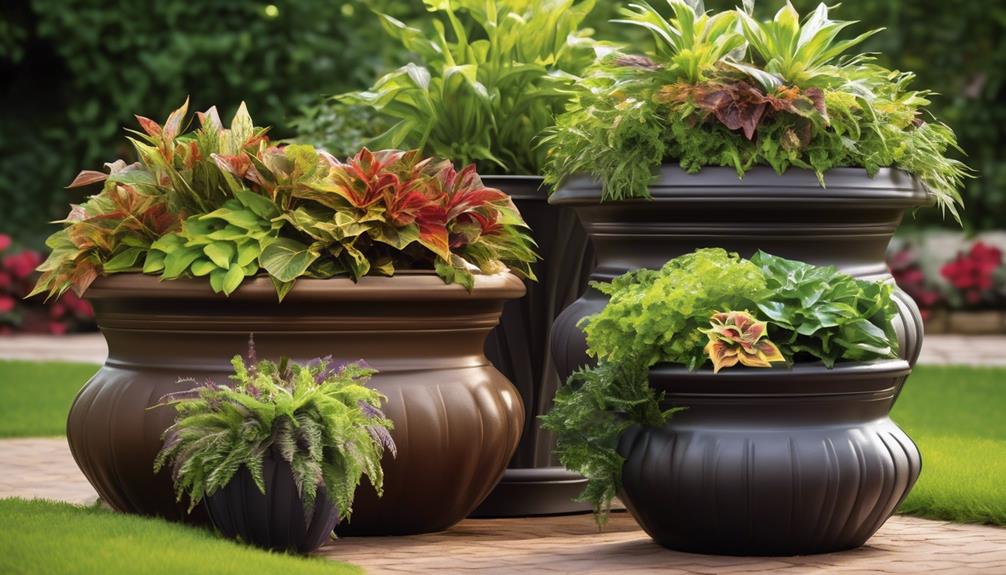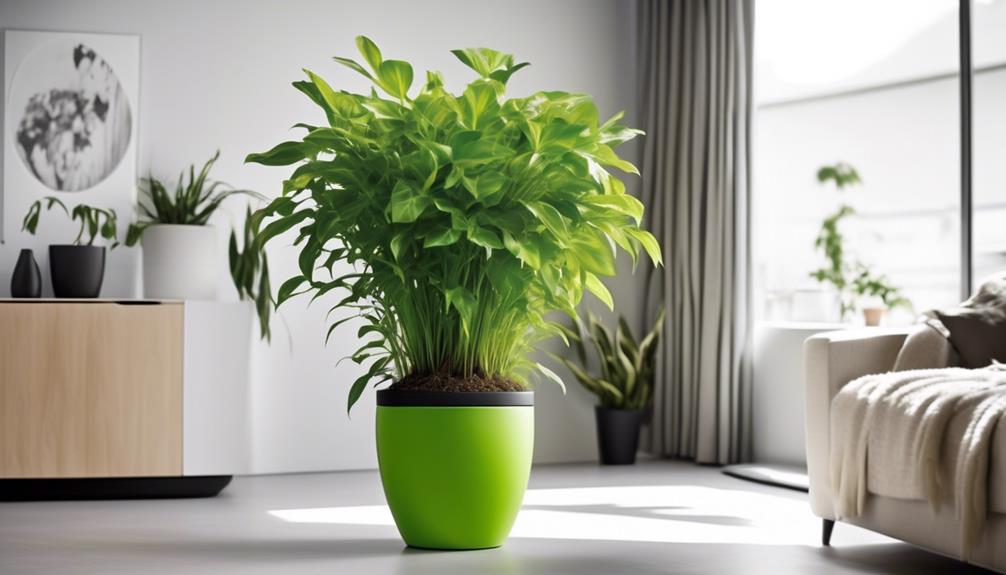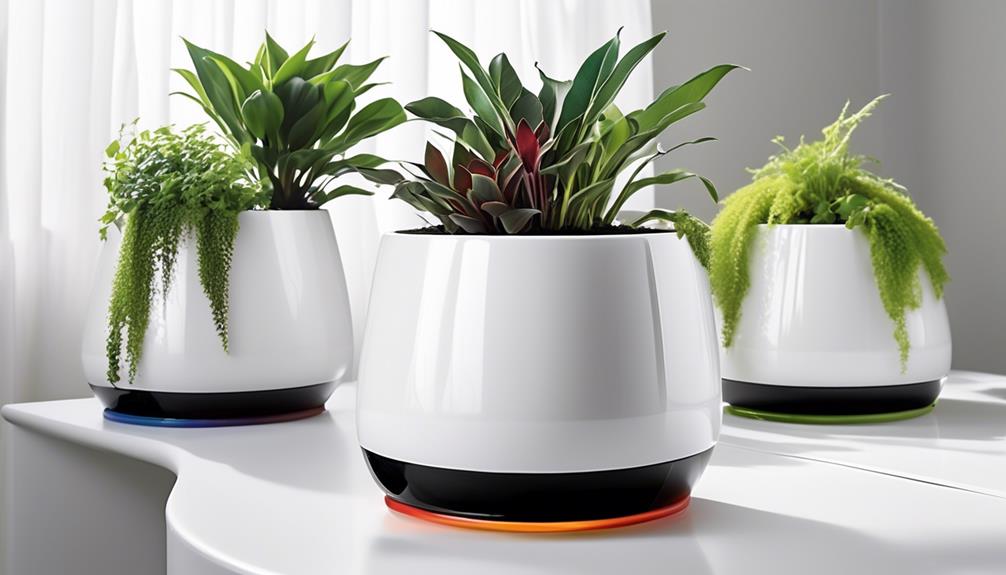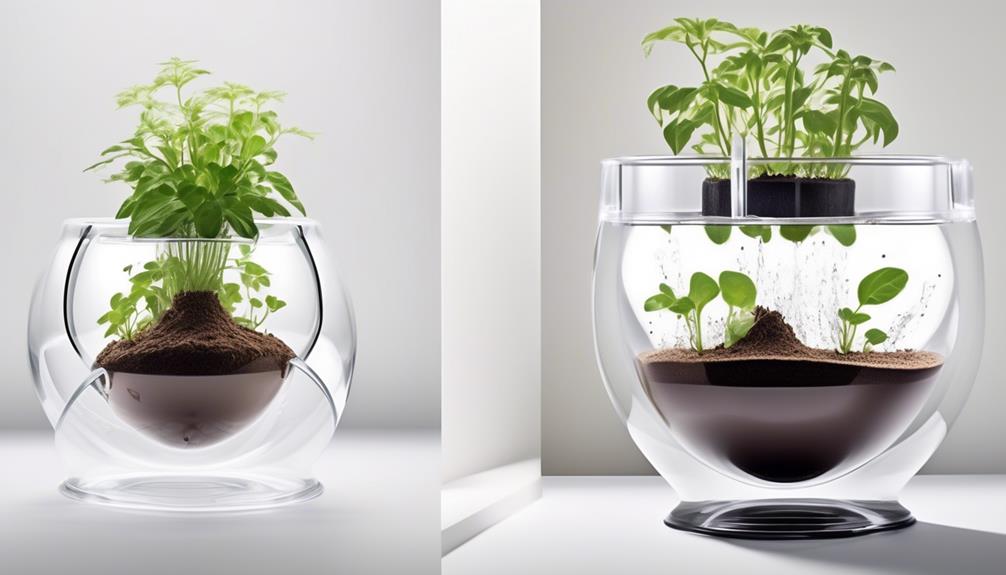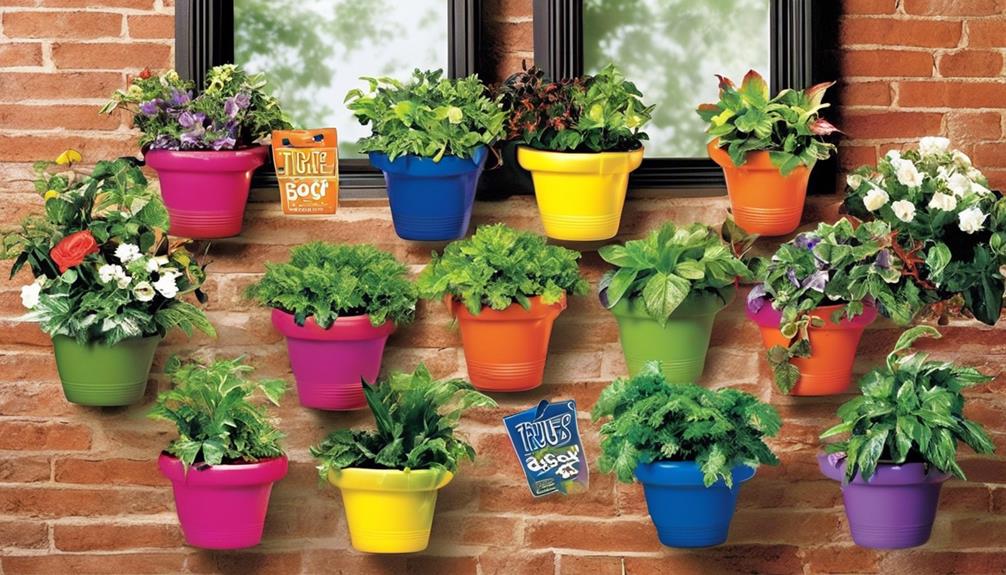Have you been thinking about ways to simplify plant care? Maybe you’re interested in self-watering planters. The real question is, do they deliver on their promises?
Well, let's just say there's a lot to unpack when it comes to the pros and cons of these nifty gardening gadgets. But before we jump into any conclusions, it might be worth taking a closer look at what self-watering planters have to offer.
Key Takeaways
- Self-watering planters improve water efficiency and reduce maintenance requirements.
- They provide precise watering for optimal growth and offer convenience and cost savings for users.
- Self-watering planters have a positive environmental impact by reducing runoff and nutrient leaching.
- They promote consistent moisture levels for healthy plant growth and have robust root systems for nutrient uptake.
Advantages of Self Watering Planters
Self watering planters offer numerous benefits, including improved water efficiency and reduced maintenance requirements. These planters utilize a reservoir system to provide water to the plants as needed, leading to significant water savings and cost efficiency. The self-watering mechanism ensures that plants receive the precise amount of water required for optimal growth, preventing water wastage and evaporation. This efficient watering system not only conserves water but also reduces the frequency of manual watering, resulting in substantial cost savings and convenience for the users.
Furthermore, the consistent moisture levels maintained by self watering planters promote healthy plant growth. The controlled watering system prevents under or overwatering, which can be detrimental to plant health. By ensuring that plants receive the right amount of water at all times, these planters contribute to improved plant vitality and vitality.
Additionally, the reduced maintenance requirements associated with self watering planters make them an ideal choice for individuals seeking low-maintenance gardening solutions.
How Self Watering Planters Work
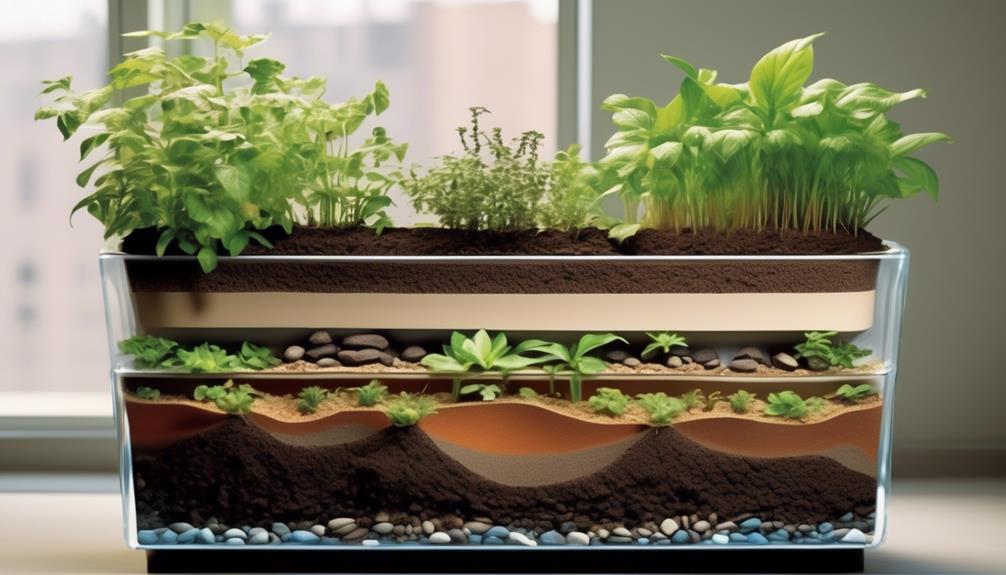
Self-watering planters operate on a simple and efficient mechanism that ensures plants receive the right amount of moisture at all times. These planters offer numerous benefits, including reduced water usage, minimized risk of overwatering or underwatering, and improved plant health.
Watering Mechanism Explanation
The irrigation system in self watering planters efficiently delivers water to the plant roots, maintaining optimal moisture levels for healthy growth. This system typically consists of a water reservoir at the bottom of the planter, connected to the soil through a wicking mechanism or capillary action. As the soil dries out, it draws up water from the reservoir, ensuring consistent moisture for the plants. This mechanism enhances watering efficiency by reducing water waste through evaporation or runoff.
It also provides a buffer against under or overwatering, as the plants can draw water as needed. Additionally, the self watering mechanism prevents waterlogging by allowing excess water to drain away from the root zone. This innovative approach to maintaining soil moisture contributes to the overall health and vitality of the plants.
Benefits of Self-Watering
Using a capillary action mechanism, the self watering planters maintain consistent moisture levels in the soil, promoting healthy plant growth and reducing water waste.
The benefits of self-watering systems include:
- Watering Efficiency:
- Self-watering planters reduce water wastage by providing just the right amount of water to the plants, avoiding overwatering or underwatering.
- The capillary action ensures that the soil retains optimal moisture, improving watering efficiency and conserving water resources.
- Environmental Impact:
- By reducing water consumption, self-watering planters contribute to environmental sustainability, making them an eco-friendly choice for gardening enthusiasts.
- The controlled watering mechanism minimizes runoff and nutrient leaching, thereby reducing the impact on the surrounding ecosystem.
- Convenience and Plant Growth:
- Self-watering planters offer convenience by reducing the frequency of watering, making them ideal for busy individuals.
- Consistent moisture levels support healthy plant growth, leading to lush and vibrant foliage.
Plant Health Improvement
Through the utilization of capillary action, self-watering planters function by consistently supplying moisture to the soil, thereby enhancing the overall health and well-being of the plants. The continuous availability of water ensures that plants receive the optimal amount of hydration, leading to improved growth and development. This method also reduces the likelihood of overwatering or underwatering, common issues associated with traditional plant care. As a result, the plants experience reduced stress and are better equipped to resist diseases and pests. Moreover, the consistent moisture levels promote robust root systems, which are essential for nutrient uptake and overall plant health. The improved plant health not only enhances the aesthetic appeal of the green space but also reduces maintenance efforts, allowing for a more sustainable and enjoyable gardening experience.
| Improved Growth | Reduced Maintenance | Enhanced Plant Health |
|---|---|---|
| Stronger, healthier plants | Less frequent watering | Reduced risk of diseases |
Types of Self Watering Planters
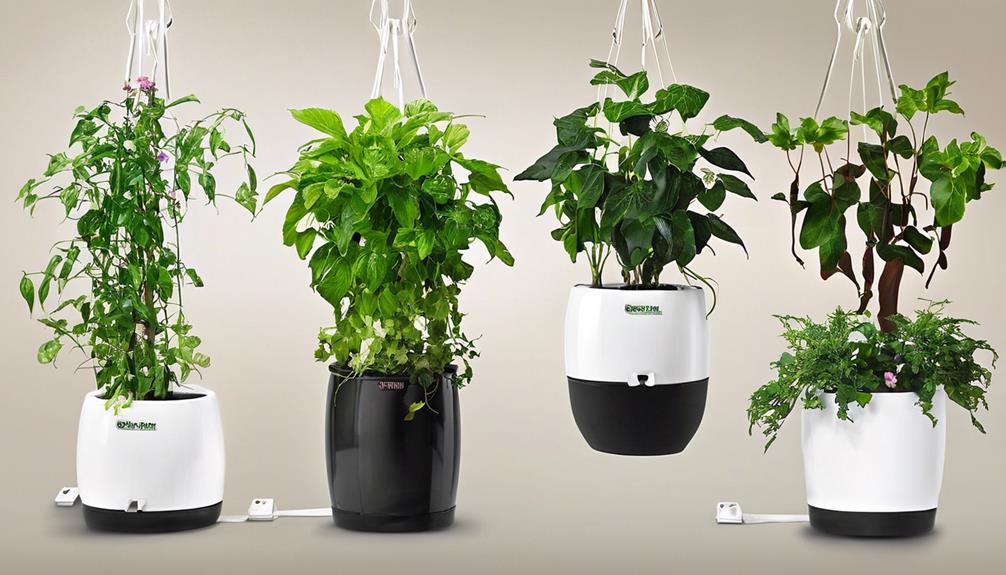
When it comes to self-watering planters, we'll be discussing the benefits of this system and the different reservoir options available.
Understanding the various types of self-watering planters can help us make informed decisions about which options are best suited for different plants and environments.
Benefits of Self-Watering
Self-watering planters, also known as self-irrigating or sub-irrigation planters, offer a convenient and efficient way to maintain optimal moisture levels for various types of plants.
The benefits of self-watering systems are numerous, including:
- Watering efficiency: Self-watering planters ensure that plants receive the right amount of water, reducing the risk of overwatering or underwatering. This promotes healthier root development and overall plant growth.
- Soil moisture: These planters help to maintain consistent soil moisture, preventing water stress and minimizing the need for frequent watering.
- Indoor, outdoor suitability: Self-watering systems are suitable for both indoor and outdoor use, allowing for flexibility in plant placement and making them ideal for various environments.
Self-watering planters are a practical solution for maintaining plant health while minimizing the effort and time required for watering maintenance.
Different Reservoir Options
We can classify self-watering planters based on their different reservoir options, which play a crucial role in maintaining optimal moisture levels for plants.
The efficiency of a self-watering planter largely depends on the material used for the reservoir. Materials like plastic, ceramic, and metal offer varying levels of water retention and durability.
Additionally, the size and placement of the reservoir within the planter are vital factors. A larger reservoir allows for less frequent refilling and provides a more stable moisture environment for the plant. Proper placement of the reservoir ensures an even distribution of water to the plant's roots.
Considering these aspects when choosing a self-watering planter can significantly impact its effectiveness in sustaining plant health. Therefore, understanding the reservoir options available is essential for making an informed decision when selecting self-watering planters.
Maintenance and Care Tips

To ensure optimal functioning and longevity of self-watering planters, regular cleaning and inspection of the watering system is essential. This helps to prevent clogging and ensures that the self-watering mechanism works effectively.
Here are some maintenance and care tips to consider:
- Cleaning: Regularly clean the watering system to remove any mineral deposits, algae, or mold that may affect its functionality. Use a mixture of water and mild soap to clean the reservoir and tubing, and rinse thoroughly before refilling.
- Inspection: Check the watering system for any signs of damage or wear, such as cracked tubing or malfunctioning float valves. Replace any worn or damaged parts to maintain the proper functioning of the self-watering planter.
- Soil Moisture Monitoring: Regularly monitor the soil moisture levels in the planter to ensure that the watering frequency is appropriate for the specific plant species. Adjust the watering frequency as needed to prevent overwatering or underwatering, which can adversely affect plant health.
Considerations Before Buying
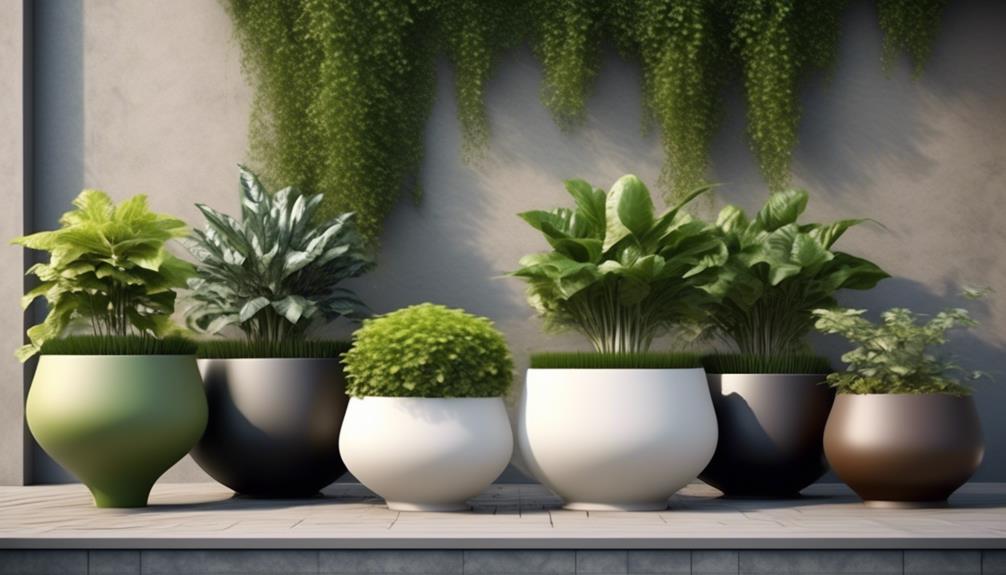
Regularly checking the maintenance needs of self-watering planters can inform the considerations before purchasing a new one. When considering buying a self-watering planter, material considerations play a significant role.
Planters made from high-quality, UV-stabilized plastic are durable and lightweight, making them suitable for both indoor and outdoor use. Additionally, materials such as terracotta or ceramic can provide a more aesthetic appeal but may require more maintenance to prevent cracking or breakage.
Size options are also crucial to consider. Larger planters offer more space for root growth and water reservoirs, reducing the frequency of refills and providing more stability for larger plants. However, smaller planters may be more suitable for limited spaces or smaller plants.
Furthermore, it's essential to consider the self-watering mechanism. Some planters have a wicking system that draws water from the reservoir into the soil, while others rely on a water level indicator to signal when it's time for a refill. Understanding these mechanisms can help determine which planter best fits the specific needs of the plants and the environment.
Lastly, considering the overall design and aesthetics in relation to the intended space is important to ensure the self-watering planter complements its surroundings.
Real Cost and Long-Term Benefits
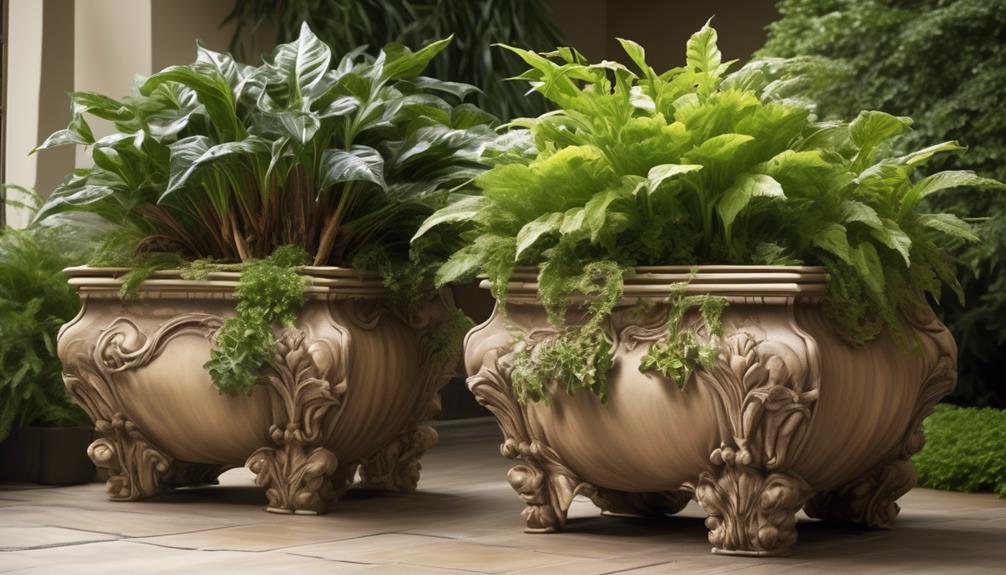
Considering the real cost and long-term benefits of self-watering planters is essential for making an informed decision about their suitability for specific planting needs. When weighing the cost comparison between traditional planters and self-watering ones, it's important to note that self-watering planters generally have a higher upfront cost. However, the long-term benefits can offset this initial investment.
Here are some key points to consider:
- Cost Comparison
- Initial Investment: Self-watering planters are more expensive upfront due to their built-in watering systems and higher quality materials.
- Long-Term Savings: Over time, self-watering planters can save money on water bills and plant replacements due to their efficient water usage and reduced risk of plant stress.
- Environmental Impact
- Water Conservation: Self-watering planters typically use water more efficiently, reducing overall water consumption and promoting environmental sustainability.
- Reduced Waste: The longevity of plants in self-watering planters can lead to less plant waste, contributing to a more sustainable gardening practice.
Carefully evaluating the cost comparison and environmental impact of self-watering planters can help determine their overall value and feasibility for long-term planting needs.
Frequently Asked Questions
Can Self Watering Planters Be Used for All Types of Plants, Including Herbs and Vegetables?
Yes, self-watering planters can be used for all types of plants, including herbs and vegetables. They offer benefits such as efficient water conservation and improved plant health.
However, drawbacks may include the initial cost and potential for overwatering.
When implementing container gardening, self-watering planters can be a valuable tool for maintaining optimal moisture levels, which is crucial for the success of various plants in a home garden setting.
Are There Any Potential Drawbacks to Using Self Watering Planters, Such as Overwatering or Root Rot?
Potential drawbacks of self watering planters include the risk of overwatering and root rot. To mitigate these issues, regular maintenance and soil recommendations are crucial.
Indoor use may require different considerations than outdoor use. Replacement of components may be necessary over time.
Understanding these factors can help in making an informed decision about the benefits and potential drawbacks of using self watering planters for various types of plants.
How Long Do the Self Watering Mechanisms Typically Last Before Needing to Be Replaced or Repaired?
The longevity of self-watering mechanisms varies depending on the quality of the planter and its components. Regular maintenance can enhance their durability. Typically, these mechanisms can last several years before needing repair or replacement.
Maintenance requirements involve periodic checks for clogs, ensuring proper water distribution, and occasional component replacement. High-quality self-watering planters may have longer-lasting mechanisms, making them a worthwhile investment for those seeking convenience and efficient plant care.
Are There Any Specific Soil or Fertilizer Recommendations for Use With Self Watering Planters?
We've conducted extensive research on watering frequency and plant growth, as well as soil moisture and nutrient uptake.
When using self-watering planters, it's essential to select a well-draining soil mix to maintain optimal moisture levels.
Additionally, incorporating a balanced fertilizer with essential nutrients, such as nitrogen, phosphorus, and potassium, can enhance plant growth.
These specific soil and fertilizer recommendations are crucial for maximizing the benefits of self-watering planters and promoting healthy plant development.
Can Self Watering Planters Be Used Indoors as Well as Outdoors?
Self watering planters offer benefits such as consistent moisture and reduced watering frequency. They're ideal for urban dwellers and those with busy schedules. Self watering planters can be used indoors. However, outdoor use may be limited by extreme weather conditions and the need for regular refilling due to higher evaporation rates. Understanding these limitations and benefits can help in making an informed decision about incorporating self watering planters into indoor and outdoor gardening practices.
Are Self Watering Planters Effective for Keeping Plants Healthy?
Yes, the benefits of self watering planters are undeniable. These planters provide a consistent supply of water, ensuring that plants receive the right amount of moisture at all times. This helps to keep plants healthy and thriving, making self watering planters an effective option for plant care.
Conclusion
In conclusion, self watering planters are definitely worth the investment for their convenience, efficiency, and long-term benefits.
The visual imagery of a self watering planter effortlessly nourishing and sustaining a healthy plant represents the practicality and ease of using this innovative gardening solution.
When considering the real cost and long-term benefits, self watering planters prove to be a valuable addition to any home or garden.

